
Picea abies, the Norway spruce or European spruce, is a species of spruce native to Northern, Central and Eastern Europe. It has branchlets that typically hang downwards, and the largest cones of any spruce, 9–17 cm long. It is very closely related to the Siberian spruce, which replaces it east of the Ural Mountains, and with which it hybridises freely. The Norway spruce is widely planted for its wood, and is the species used as the main Christmas tree in several countries around the world. It was the first gymnosperm to have its genome sequenced. The Latin specific epithet abies means “fir-like”.
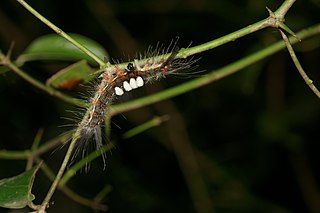
The Lymantriinae are a subfamily of moths of the family Erebidae. The taxon was erected by George Hampson in 1893.

Abies sachalinensis, the Sakhalin fir, is a species of conifer in the family Pinaceae. It is found in Sakhalin island and southern Kurils (Russia), and also in northern Hokkaido (Japan). The first discovery by a European was by Carl Friedrich Schmidt (1832-1908), the Baltic German botanist, on the Russian island of Sakhalin in 1866, but he did not introduce it to Europe. The plant was re-discovered by the English plant-collector, Charles Maries in 1877 near Aomori on the main Japanese island of Honshū, who initially thought it to be a variety of Abies veitchii. Abies nephrolepis(khingan fir) is known to be the closest relative. Which is on the mainland just west of the range of Sakhalin fir.

Dasychira is a genus of tussock moths in the family Erebidae described by Jacob Hübner in 1809. They are well distributed all over Africa, Europe, Madagascar, Japan, China, India, Sri Lanka, Myanmar, Java and Australia.

Dasychira grisefacta, the pine tussock or grizzled tussock, is a moth of the family Erebidae. The species was first described by Harrison Gray Dyar Jr. in 1911. It is found in North America in Alberta, from British Columbia to Arizona and Oregon, in New Mexico, Montana, South Dakota and North Dakota.

Dasychira pinicola, the pine tussock moth, is a moth of the family Erebidae. The species was first described by Harrison Gray Dyar Jr. in 1911. It is found in the US states of New Jersey, Massachusetts, Wisconsin and Minnesota.
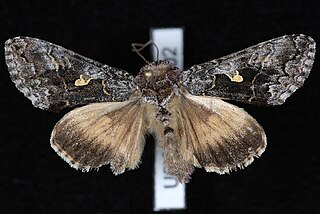
Syngrapha celsa, the plain silver Y or western conifer looper, is a moth of the family Noctuidae. The species was first described by Henry Edwards in 1881. It is found in North America from British Columbia to California, Idaho, Nevada, Arizona and New Mexico.
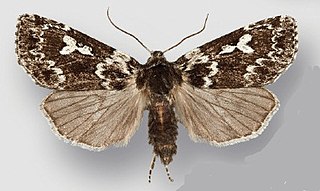
Xestia perquiritata, the boomerang dart, is a moth of the family Noctuidae. The species was first described by Herbert Knowles Morrison in 1874. It is found across North America from Newfoundland, Labrador and northern New England, west to central Yukon, British Columbia and Washington. There are several disjunct populations, including one in the Great Smoky Mountains National Park and the Rocky Mountains in Colorado and a coastal bog in central Oregon.

Dasychira basiflava, the yellow-based tussock, is a moth of the family Erebidae. The species was first described by Alpheus Spring Packard in 1865. It is found in North America from Massachusetts and southern Ontario west to Iowa, Texas, south to South Carolina and possibly Florida.

Coniferous swamps are forested wetlands in which the dominant trees are lowland conifers such as northern white cedar. The soil in these swamp areas is typically saturated for most of the growing season and is occasionally inundated by seasonal storms or by winter snow melt.

Orgyia pseudotsugata, the Douglas-fir tussock moth, is a moth of the subfamily Lymantriinae first described by James Halliday McDunnough in 1921. It is found in western North America. Its population periodically irrupts in cyclical outbreaks. The caterpillars feed on the needles of Douglas fir, true fir, and spruce in summer, and moths are on the wing from July or August to November.
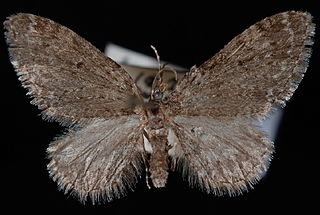
Eupithecia annulata, the larch pug moth, is a moth in the family Geometridae. The species was first described by George Duryea Hulst in 1896. It is found in North America from British Columbia north to the Yukon, east to Newfoundland and Labrador and south to California and Colorado.

Dasychira vagans, the variable tussock moth, is a moth of the family Erebidae. It is found in North America, where it has been recorded from Newfoundland to southern British Columbia in the north and North Carolina and Utah in the west. The habitat consists of forests, including coastal rainforests, high elevation mixed hardwood-conifer forests, oak woodlands and mixed hardwood forests. The species was first described by William Barnes and James Halliday McDunnough in 1913.

Hydriomena divisaria, the black-dashed hydriomena moth, is a moth in the family Geometridae. It is found in North America, where it has been recorded from southern Canada and the northern United States, south to Georgia in the east.
Dasychira dorsipennata, the sharp-lined tussock or hardwood tussock moth, is a species of tussock moth in the family Erebidae. It was first described by William Barnes and James Halliday McDunnough in 1919 and it is found in North America.

Dasychira dominickaria, or Dominick's tussock moth, is a species of tussock moth in the family Erebidae. It is found in North America.
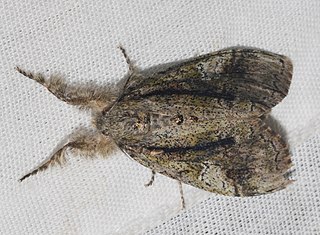
Dasychira tephra, the tephra tussock moth, is a tussock moth in the family Erebidae. The species was first described by Jacob Hübner in 1809. It is found in North America.

Dasychira leucophaea, the pale-banded tussock moth, is a species of tussock moth in the family Erebidae. It is found in North America.
















